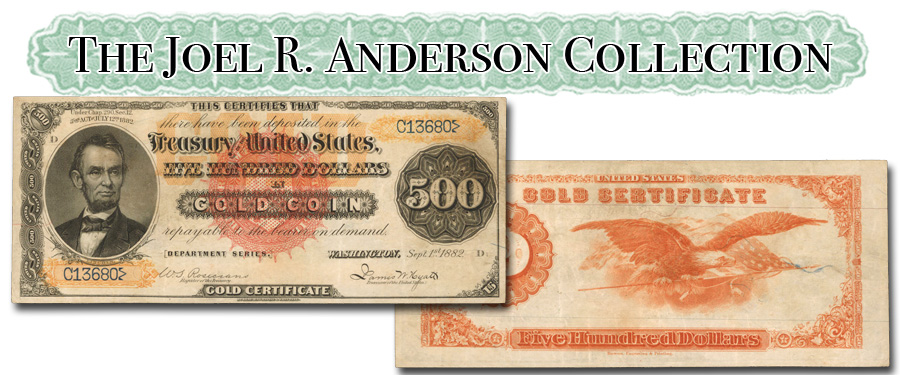
We continue our discussion and preview of the Joel R. Anderson Collection Part III. Featuring rarity after rarity plus many more-available notes affordable to a wide circle of buyers, the sale will be held on Thursday evening, October 25, at the Whitman Coin & Currency Expo in Baltimore. You are invited to attend in person or to participate in virtual reality on the Internet.
The Anderson Collection was formed starting years ago. Joel, a connoisseur par excellence, determined to acquire one each of the large-size federal currency designs from 1861 to 1928. Year by year the collection grew as he won notes at auction and bought others privately. The objective was to obtain the finest possible condition.
Today the Anderson Collection is unique in that no other currency collection has ever been so complete as to types and quality. Opportunity is the key word here. There are many notes such as this unique $500 Large Red Spiked Seal Gold Certificate that may never be offered again in your lifetime—or if it is acquired by an institution it will be off the market forever.
Our catalog description is given below.
Lot 3044. Friedberg 1215d (W-4206). 1882 $500 Gold Certificate. PCGS Currency Very Fine 35.
Before the discovery of this note "out of the weeds" in 2013, the only known example of this large red spiked seal 1882 $500 Gold Certificate resided permanently in the collection of the Federal Reserve Bank of San Francisco. While many of the design motifs for this catalog number resemble more commonly encountered $500 Gold Certificates of 1882 and 1922, the large red spiked Treasury Seal instantly distinguishes this note from those. This Fr.1215d (W-4206) is easily one of the most incredible Gold Certificates in existence, right up there with the Series of 1863 notes.
Just 16,000 pieces were printed for the catalog number. The portrait of Abraham Lincoln seen at left was engraved by Charles Burt and based on a photograph by Mathew Brady. All of the design elements are presented in sharp detail by boldly printed inks. The Treasury Seal is strikingly printed and retains brilliant color.
The orange-gold printed back has a particularly dynamic motif, Eagle with Flag, engraved by George D. Baldwin, who at an earlier time created some of the most elegant artwork seen on notes of state-chartered banks. His Ocean Telegraph vignette appears on the back of the $20 Gold Certificate, Series of 1882.
Broad margins are observed on creamy white paper which displays only a modest degree of light circulation.
The Act of January 1934 made the holding of Gold Certificates illegal. Unlike the case for gold coins after Franklin D. Roosevelt’s gold surrender order of March 1933 and subsequent actions, any notes held by numismatist were not exempt. The vast majority were surrendered. It is unlikely that many were in numismatic hands, for large-size federal notes were not widely collected. Virgil M. Brand, who died in 1926, had many notes of various series, but most were cashed in for face value by his heirs. Albert A. Grinnell, the Detroit collector whose holdings were auctioned by Barney Bluestone in the 1940s, may have had some, but this is not known. None appeared in the sales.
The writer (QDB) recalls that in the 1950s he often received Gold Certificates at face value from collectors who were holding them privately. These were turned in for face value at the Marine Midland Bank in Johnson City, New York. These were all smaller denominations—up to $50 with an occasional $100, but none higher. All were 20th century issues.
In the 1960s Amon Carter, Jr., who had connections to Congress, persuaded the Treasury Department to change the rules. Since that time Gold Certificates have been eagerly sought. The pedigrees of large denomination notes such as this $500 are not known, but it is likely that most came from overseas sources where they were legally held. As is known, many $500 and $1000 bills of the Legal Tender and Silver Certificate series were repatriated after World War II. In any event, such overseas holdings were small in comparison to federal gold coins desired by leading banks and government treasuries.
Today $500 and $1000 notes such as the Anderson Collection treasures are the stuff of which dreams are made. This note realized $1,410,000 when sold at auction in January 2014. It is the only collectible example of the catalog number and seal type for the design. We expect this note will be tucked away for quite some time once it crosses the auction block.
PCGS Population: 1, none finer.
From Heritage Auctions’ sale of January 2014.
Est. $1,000,000-$1,500,000





